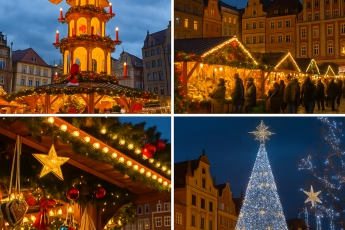- Where is Tumski Bridge located?
- A brief history of Tumski Bridge
- Bridge architecture – what to know
- A car-free bridge – a peaceful walking route
- The Lovers’ Bridge – where does the name come from?
- Love locks – safety and current rules
- Tumski Bridge after dark
- How to reach Tumski Bridge?
- From the Market Square (approx. 12–15 minutes on foot)
- From the Main Railway Station (25–30 minutes on foot)
- Where to park near Tumski Bridge?
- Fun facts about Tumski Bridge
- ❓ FAQ – Tumski Bridge and the Lovers’ Bridge in Wrocław
Tumski Bridge is one of the most recognisable crossings in Wrocław. It connects Piasek Island with Ostrów Tumski, leading directly towards the Cathedral of St John the Baptist. The current steel structure dates back to 1889 and is one of the best-preserved truss bridges in Poland. The bridge is reserved exclusively for pedestrians and cyclists – it forms part of the main walking route through the oldest part of the city.
Where is Tumski Bridge located?
The bridge lies right in the city centre, between the cathedral and Piasek Island. It is an ideal starting point for exploring Ostrów Tumski, taking walks along the Oder River and photographing sacral architecture.
Location: Katedralna Street → Piasek Island
Access: 24/7, free of charge, pedestrian and bicycle traffic only
A brief history of Tumski Bridge
The first crossings at this location existed as early as the Middle Ages. They were wooden bridges that were regularly destroyed by floods or fires.
In the 19th century, during the rapid development of Breslau, it was decided to build a modern steel structure. The design was prepared by Richard Plüddemann, and the construction was carried out by the renowned factory Beuchelt & Co. from Zielona Góra.
The bridge was opened in 1889, and its appearance has not changed significantly since then. It survived wars, urban modernisation and several renovations (including in the 1990s and in 2019).
Bridge architecture – what to know
Tumski Bridge is distinguished by its characteristic arched steel truss, connected with rivets – the original ones from the 19th century.
Bridge parameters:
- Length: 52.2 m
- Width: 6.8 m
- Structure: riveted steel, arched
- Colour: blue-green (historical conservation scheme)
Decorative posts and elements of the original infrastructure are still visible on the abutments.
A car-free bridge – a peaceful walking route
Today, Tumski Bridge serves exclusively pedestrians. With no car traffic, it is one of the most pleasant places for a walk in central Wrocław. From the bridge you can see the cathedral, the buildings on Piasek Island and the Oder – each time of day offers a different view.
The Lovers’ Bridge – where does the name come from?
Although the official name is Tumski Bridge, many locals and tourists know it as the Lovers’ Bridge. The tradition of attaching love locks began around 2009 and quickly became popular. There were thousands of them – so many that in 2019 the city removed most to relieve the structure.
Today, individual locks still appear, but the authorities encourage alternative symbolic gestures (e.g., taking a photo together with the bridge and cathedral in the background).
➡️ Important: attaching locks is not formally prohibited, but discouraged for technical reasons.
Love locks – safety and current rules
- The removal of locks in 2019 was necessary due to overloading of the railings.
- The structure was renovated and reinforced during restoration.
- Individual locks still appear, but attaching them in large numbers is not recommended.
- Throwing the key into the Oder can be treated as environmental pollution.
Tumski Bridge after dark
In the evening, the bridge is illuminated by the gas lamps of Ostrów Tumski, lit daily by the lamplighter in a traditional uniform. It is one of the last places in Europe where such an installation still operates.
The best photos are taken:
- at sunrise – no crowds, soft light,
- right after sunset – the “blue hour” over the Oder,
- in winter – when the cathedral and the bridge are illuminated.
How to reach Tumski Bridge?
From the Market Square (approx. 12–15 minutes on foot)
- Kuźnicza St → University Square → University Bridge → Piasek Island
or
- Oławska St → Galeria Dominikańska → Xawery Dunikowski Boulevard → Piasek Island
From the Main Railway Station (25–30 minutes on foot)
- via Galeria Dominikańska and Peace Bridge
- or by tram 2, 8, 9, 11, 17 (stop: “Hala Targowa”)
Where to park near Tumski Bridge?
There is a no-entry zone directly around the bridge.
- Nowy Targ (P1) – 8–10 minutes on foot
- Galeria Dominikańska (P2) – 10–12 minutes on foot
- Plac Bema – paid parking zone
For visitors with children or luggage, the best option is to park at Galeria Dominikańska and walk along the boulevards.
Fun facts about Tumski Bridge
- The bridge was intended for pedestrians only from the very beginning – no carts or cars have ever used it.
- The structure is held together by more than 3000 historic rivets.
- The bridge used to be painted black; the blue-green colour is the result of later conservation work.
- During World War II, the bridge was not destroyed, unlike many other Wrocław crossings.
- Richard Plüddemann also designed bridges in Berlin and Königsberg.
- In the interwar period, a special information plaque about the cathedral was placed on the bridge.
- It is one of the most photographed landmarks in the city – even more than Centennial Hall.
- In 2023, it ranked in the TOP 10 of “the most romantic places in Poland” according to several travel portals.
- The bridge appears in films, city promotional materials and many wedding campaigns.
- It is the only bridge in Wrocław where engagement photo sessions regularly take place.







